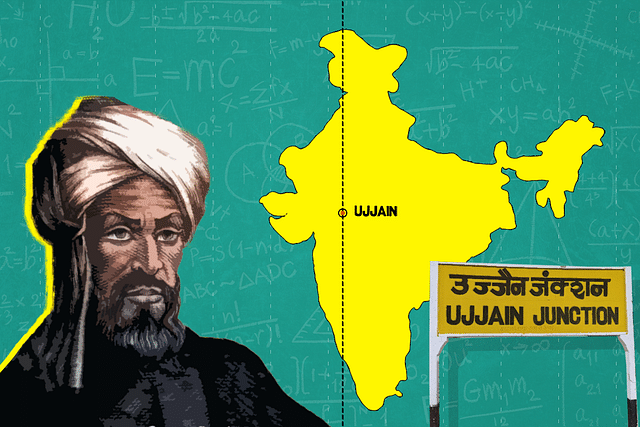Ideas
Ujjain's Prime (Meridian) Is Past, To Get It Back We Need An Indian Renaissance

The call for Ujjain to once again 'become' the Prime Meridian should be seen as an assertion of the global south's history.
Ujjain was recently in news after the recently sworn in Chief Minister of Madhya Pradesh Mohan Yadav said, among other things, that he would work to shift the Prime Meridian from Greenwich to Ujjain.
Some have mocked this statement while some have dwelt on history to verify Yadav's claims. We'll try and do the latter.
What do we know about Ujjain and the Prime Meridian?
We could begin with Al-Khwarizmi, a famous polymath who lived in the ninth century Baghdad.
Al-Khwarizmi was a great civilisational figure who transmitted knowledge of the east to the west. The word algorithm comes from his name. He was also a Sanskrit scholar.
During Al-Khwarizmi's time, and perhaps before, Hindu pundits were known to have been visited by and interacted with the scholars of Baghdad, a fact that goes against later Islamic chroniclers' claim that the Hindus were a close-minded people.
Important books of Al-Khwarizmi include Kitab a hisab al-hindi (Book of Hindu Mathematics) and Zij al Sindhind (astronomy tables from India). His most famous work was Kitab al-jabr wa-al-muqabalah. It also owes it to Hindu mathematics, a fact that was acknowledged by Al-Khwarizmi himself.
In Zij al Sindhind, his astronomical work, he uses Ujjain as the prime Meridian because Ujjain was the prime meridian for Hindus whose knowledge he was using in his own other astronomical observations and calculations.
The entry for the ‘transmission of Indian science and philosophy’ in The Oxford Encyclopedia of Philosophy, Science, and Technology in Islam has this to say about the acceptance of Ujjain as Prime Meridian by most of the then Arab world:
The Hindu civilisation had two models of the universe — one was spherical, another was flat-earth. There were contradictory descriptions in Puranic and astronomical treatise.
But what is important is that the Hindu astronomy and spirituality could develop an atmosphere of non-contradiction (avirodha) which in turn allowed both physical science and inner science to grow.
In particular, the Hindu way of internalising Puranic cosmography created a very pragmatic space for Hindu astronomers to deal with contradictions between the textual cosmology of Puranas and empirical observations of Siddhantic astronomy.
We see an uninterrupted evolution of Hindu astronomy and mathematics that led to mathematical geography based on Ujjain Prime Meridian and creation of tables providing latitudes and longitudes of places in India and beyond.
Prime Meridian is more a conventional conjecture agreed upon by astronomers of a society to observe the skies. It is a delicate node where the elements of culture and the needs for empirical observations intersect.
For Hellenistic astronomy, Alexandria was considered the Prime Meridian. This notion even came upto India and along with the predatory armies of Alexander, the terrible.
But Indian astronomical tradition made Ujjain the Prime Meridian and through its sheer brilliance made it acceptable for the builders of knowledge in Baghdad.
Through Spain, Zij al Sindhind became the most important astronomical book of Europe and the famous Toldedo tables and Alfanso tables were based on this text. Petrus Alfonis maps also show that they centred around a place called Arin or Aren. This was the legacy of Zij al Sindhind.
This Arin was none other than Ujjain. Even certain Christian attempts to make Jerusalem the central meridian could not become successful. These tables dominated European astronomy from fourteenth century to the time of Copernicus.
So truly, Ujjain was indeed the Prime Meridian of medieval world, so much so that it was called the centre of the inhabited world by Latin sources.
That brings us to the question of modern Greenwich. It was in 1884 through an international convention that Greenwich was agreed upon as international Prime Meridian.
It was a decision in a world of colonialism ravaged by El Nino famines and drainage of wealth from Asia and Africa into Europe. This was a convention that was imposed upon all, and modern world today stands on that meridian.
As against this, Ujjain as Prime Meridian is not based on a dogmatic faith or imperial legacy. It was more because of knowledge generation than exploitation that Ujjain remained the Prime Meridian.
Ujjain could transcend linguistic, racial, religious boundaries and more importantly it emerged from a knowledge tradition rather than being imposed from above by an elite class of international imperial exploiters, however convenient today it might have become.
The call for Ujjain to once again 'become' the Prime Meridian of the world should be seen neither as revivalism nor regressive thinking but as an assertion of the global south's history.
But for Ujjain to once again become the centre of the world we need more than grand rhetoric. Only by making India a net knowledge producer with institutions of immense scientific depth can this be possible. Will the Chief Minister sign up for that goal?
Support Swarajya's 50 Ground Reports Project & Sponsor A Story
Every general election Swarajya does a 50 ground reports project.
Aimed only at serious readers and those who appreciate the nuances of political undercurrents, the project provides a sense of India's electoral landscape. As you know, these reports are produced after considerable investment of travel, time and effort on the ground.
This time too we've kicked off the project in style and have covered over 30 constituencies already. If you're someone who appreciates such work and have enjoyed our coverage please consider sponsoring a ground report for just Rs 2999 to Rs 19,999 - it goes a long way in helping us produce more quality reportage.
You can also back this project by becoming a subscriber for as little as Rs 999 - so do click on this links and choose a plan that suits you and back us.
Click below to contribute.
Latest